Hi everyone,
Today I’d like to introduce you one of the fastest ways to make pickles. In Vietnam, we have so many kinds of pickles from a variety of different ingredients. The way we make pickles is much simpler with just a few ingredients, but still yummy. Here comes the quickest daikon (radish) pickles dish for you guys (called Do chua or cu cai muoi soi). Of course, you can use this method of making pickles for any other vegetables.
Do chua (Daikon pickles) is a very quick and easy dish, but it plays an extremely important part in making Vietnamese banh my and other dishes. I would say Banh my would never has a good taste without Do chua (Daikon pickles). The good thing is that the ingredients to make Do chua (Daikon pickles) are easy to find from anywhere. And it is even better because the method of making this is much easier than you thought.
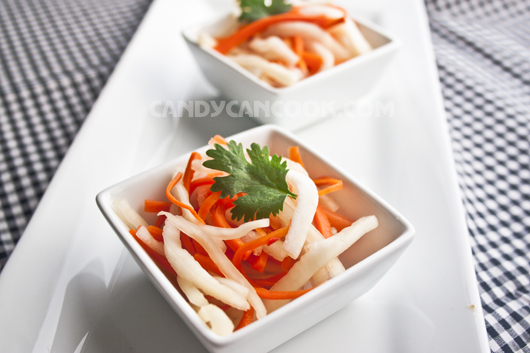
Pickled Daikon and Carrots (Do chua)
If you have ever tried Vietnamese food, sure thing that you must have eaten Do chua at least once. Do chua (Daikon pickles) is not only use for Banh my but for a lot of other Vietnamese dishes such as Bun cha/ Bun thit nuong (Vietnamese grilled pork and meatball with rice vermicelli); Bun thang (Hanoi Chicken Vermicelli) or even it could be a side dish to eat with rice in a normal meal. My husband love pickled stuffs, so I usually make a lot and store them in the fridge up for a month. It’s so convenient to grab them and make a loaf of Banh my whenever I need.
The technique to make Do chua (Daikon pickles) is somewhat the same as the way we do with onions in Goi ga xe phay (Vietnamese shredded chicken salad). We let the daikon and carrots (I add carrots for color) sit with some salt to sweat a bit before rinsing them with water and add sugar, vinegar to taste. That way would make the daikon and carrots be cooked a bit in salt (as my mom said). Therefore, only after a few hours, you could eat this pickles right away.
- Ingredients:
- 500 grams daikon or radish (about 1.1 lbs)
- 200 grams carrots (about 0.45 lbs) (Note that you can add more or less carrots as desired)
- 1 ½ Tablespoons salt
- 3 Tablespoons rice white vinegar (or distilled vinegar)
- 6 Tablespoons granulated sugar
- 2 – 3 red chilies (to your taste, optional), finely chopped
- Intructions:
- Peel and clean daikon (radish) and carrots. Use a knife to julienne them (cut into small strips). Note: don’t use a vegetable grater because it could make the daikon and carrots too wet. Use a knife would help make them crunchier.
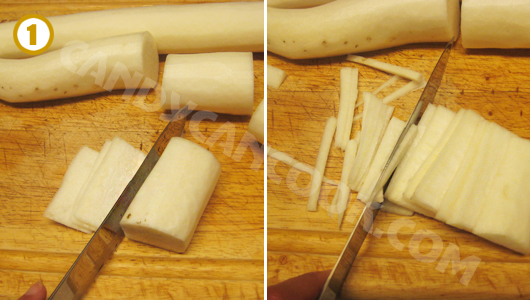
How to julienne daikon and carrots
- Place all in a big bowl, then sprinkle with salt. Use your fingers to toss them over well and let them sit for about 45 minutes. The volume of daikon and carrots would decrease.
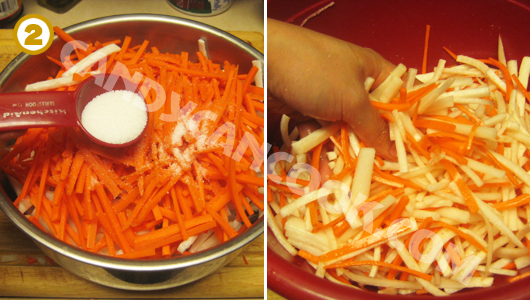
Toss the daikon and carrots with salt
- Rinse the daikon and carrots in water for 2 -3 times. Let them sit for about 10 minutes to reduce the excess water
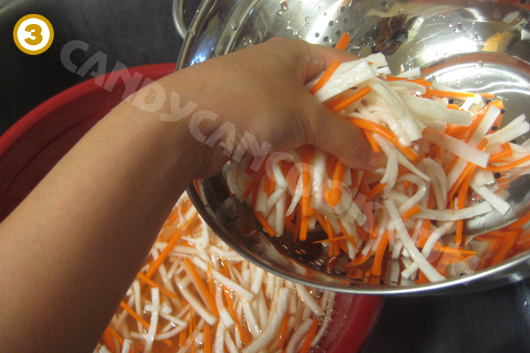
Rinse them in water for 2 – 3 times
- Put them back to the bowl, add vinegar, sugar and chopped chilies. Toss well and correct the seasoning again.
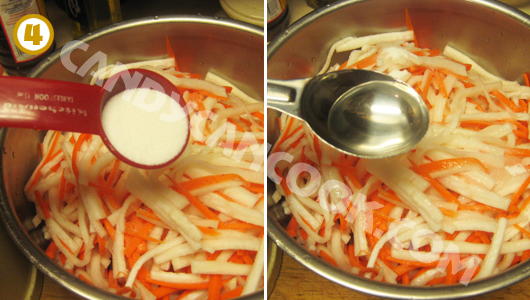
Add sugar, vinegar to the pickles
- Pack the pickled daikon and carrots into a glass jar and store in the fridge up for about a month.
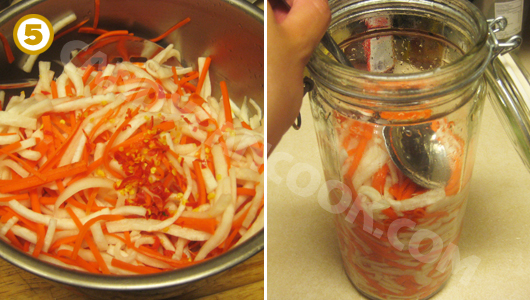
Pack the pickles into a glass jar to store
So this is your pickled daikon (radish) and carrots (do chua). You can eat right away after making this pickles. Eating them with rice with some roasted pork belly (thit quay hung liu) or caramelized pork belly (thit kho trung) would be a very good way.
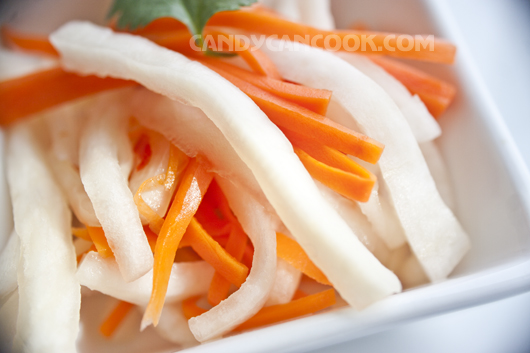
Tasty Pickled Radish and Carrots
The pickles should be tasty (sweat and sour, but not salty) and crunchy. This way would make Do chua (pickled daikon) not too watery, so that you can put them in Banh my. So guest what, next entry I’ll show you how to make Banh my to make use of Do chua ^^
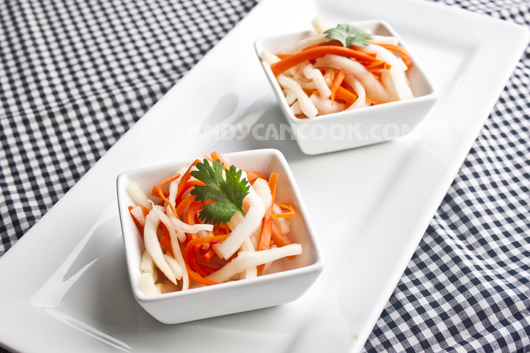
Pickled Daikon (Do chua) – an easy way to make pickles

Ingredients
- 500 grams daikon or radish (about 1.1 lbs)
- 200 grams carrots (about 0.45 lbs) (Note that you can add more or less carrots as desired)
- 1 ½ Tablespoons salt
- 3 Tablespoons rice white vinegar (or distilled vinegar)
- 6 Tablespoons granulated sugar
- 2 – 3 red chilies (to your taste, optional), finely chopped
Instructions
- Peel and clean daikon (radish) and carrots. Use a knife to julienne them (cut into small strips). Note: don’t use a vegetable grater because it could make the daikon and carrots too wet. Use a knife would help make them crunchier.
- Place all in a big bowl, then sprinkle with salt. Use your fingers to toss them over well and let them sit for about 45 minutes. The volume of daikon and carrots would decrease.
- Rinse the daikon and carrots in water for 2 -3 times. Let them sit for about 10 minutes to reduce the excess water
- Put them back to the bowl, add vinegar, sugar and chopped chilies. Toss well and correct the seasoning again.
- Pack the pickled daikon and carrots into a glass jar and store in the fridge up for about a month.

10 comments
Ngu phap tieng Anh chi gioi qua. Nguong mo.
Cám ơn em quá khen :D Chị viết vẫn còn sai nhiều lắm nhưng mà cố gắng truyền tải thông tin mọi người hiểu ^^
Hi Candy,
Just I am new to your website. Thanks for sharing delicious Vietnamese recipes with beautiful pictures.
I have made this recipe to my husband last week and it came out nice and crunchy. Now he is asking me to make banh mi with it. :)
Hi Nancy, glad to know you :) I’ll update my way to make banh mi very soon :D Thanks!
[…] like to know about Vietnamese cuisine. In my last entry, I already introduced you guys my recipe of making Do chua (Daikon pickles) to have with Banh mi. […]
Hi chị Candy,
Dạo này chị không viết blog tiếng Anh nữa ạ? Em gửi cho anh người yêu em đọc và ảnh nấu được vài món theo hướng dẫn của chị đó chị hihi
Hi Ngân, chị cũng muốn update blog TA lắm mà vẫn chưa có điều kiện em ạ. Sắp tới chắc sẽ quay lại nhanh thôi ;) Em ủng hộ nhé! Cám ơn em!
[…] When it’s done, the pork belly should be tender and both eggs and pork belly looks golden brown because of the caramel color. I always leave some water left because now the caramelized sauce is really delicious. The process of making Thit kho trung is not so difficult, but the taste is so yummy. You can have this dish with normal rice or sticky rice. (Here is the link for you to cook sticky rice by microwave). In addition, Thit kho trung goes very well with some kind of pickles (Please see this link to see how to make Vietnamese pickled mustard greens or Do chua (Pickled Radish)) […]
chị sống ở VN hay ở hải ngoại ạ?
Hi Quy, chị đang ở Mỹ em ạ :)